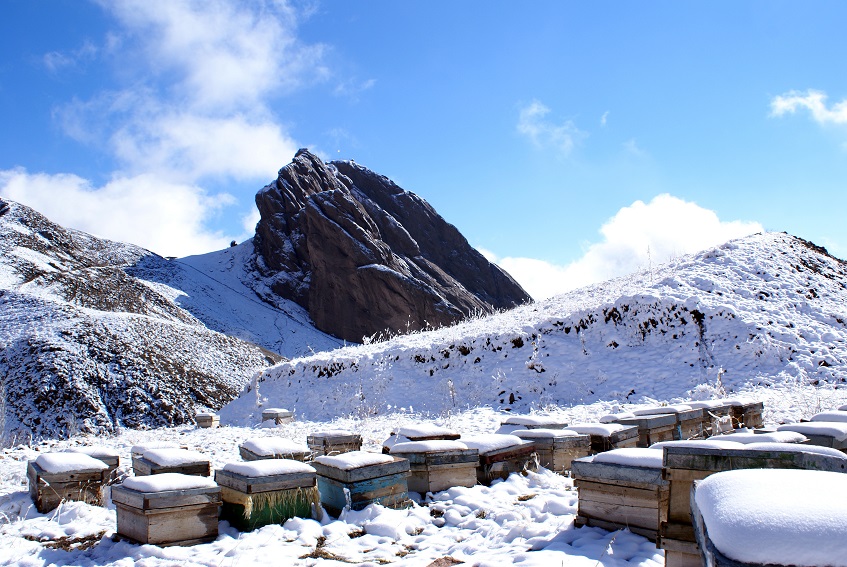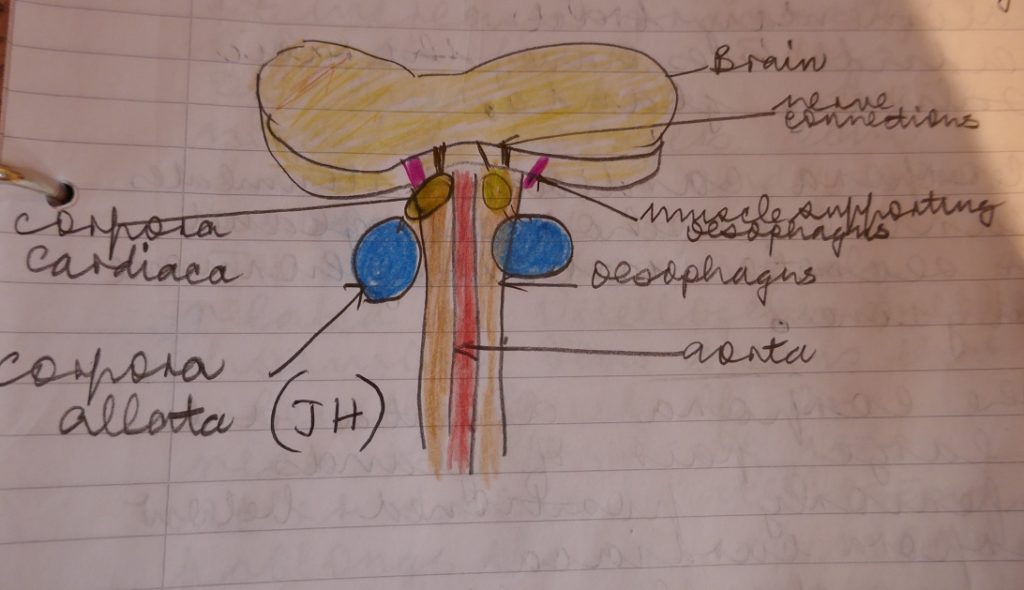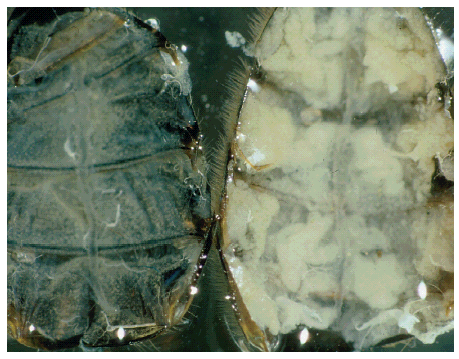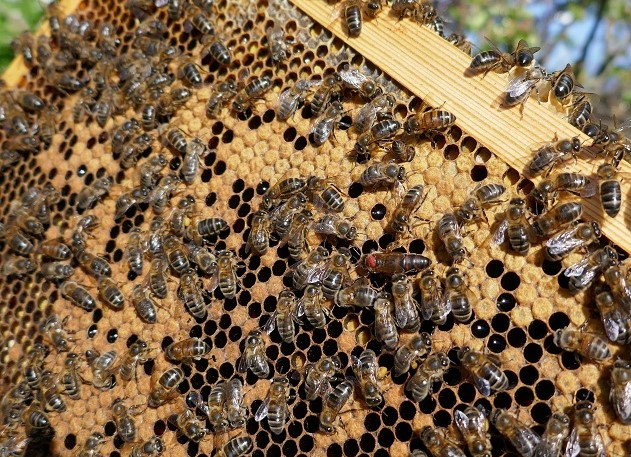
Winter Bees.
Have you ever wondered how it can be that honey bees in winter live around 4 times longer than their summer sisters? It’s easy to understand why they must when you consider that in temperate climates queen egg laying reduces to almost nothing for a period over winter. This results in fewer new bees being produced at a time when a good volume of bees is required to maintain the winter cluster and keep the colony warm until the spring colony build up. If they didn’t live longer than a few weeks the colony would soon die out. Unless we open up a colony to examine the brood nest in winter, we cannot really know when exactly the queen stops laying, or for how long. This might be a small research job for me in my own apiary so that I can better time winter varroa treatment.
However, work done in the 1950’s by M Delia Allen (1) in Aberdeen shows that the first major decline in brood rearing occurred in August both in the south of England and northern Scotland despite the obvious marked differences in available forage, and to a lesser degree the climate differences. Allen’s study also features a graph showing little brood between mid-September and April. It doesn’t tell us that there was no brood at all, but work by Michael L. Smith (2), carried out on an unmanaged colony in a large observation hive in Ithaca, New York, between December 2012- October 2013, shows that no brood was produced between early October and early April. Later Scottish work done in Aberdeen by Bernard Mobus around the 1980’s showed that some of his study colonies had no brood between mid- November and mid- December (3). So, most colonies in Scotland and New York in the 1950s, 1980’s and 2012 were broodless over winter.
The key thing is that winter bees must live longer to keep the colony going till spring.
Varroa Treatments.
I work on the assumption that, where I live, the queen probably starts egg laying again around the winter solstice on December 21st. Based on this, I use sublimated oxalic acid from mid-November –mid-December to try to reduce levels of phoretic varroa mites (varroa on bee bodies rather than in the brood cell). A broodless period is ideal for this method of varroa treatment which will not kill varroa in the cell as does formic acid for example. I try to sublimate on a day when the cluster is not too densely packed so that the vaporised white cloud of heated oxalic acid crystals penetrates the cluster.
Oxalic acid in solution, dribbled across the seams of brood, works best at colder outdoor temperatures when the bees are tightly clustered. This method is a good one for beekeepers who are concerned about the dangers of using vaporised acid. In fact, Danish beekeepers have been using this method for years and wouldn’t consider sublimation.
What Makes a Winter Bee?
Why winter bees must live longer is less complicated to grasp than the associated biology. If you’ve been studying for any beekeeping exams you have probably read that the winter bee differs from the summer bee physiologically. A couple of differences, always listed in textbooks, are that the winter bee has increased fat body tissue and low levels of juvenile hormone compared to the summer bee where the situation is the opposite. But what does this actually mean? I shall attempt to unravel some of the biology surrounding the facts. However, this may take some time so I advise you to get the kettle on for a strong brew and move closer to the fire if you’re in the northern hemisphere.
Hormones.
Like we humans who rely upon hormones from endocrine glands to keep our bodies functioning normally across all systems, honey bee body functioning is also largely orchestrated by hormones.
Juvenile hormone or neotenin plays a big role in larval development. It works in tandem with another hormone whose role it is to stimulate the prothoracic glands to produce the moulting fluid called ecdysone that allows the larva to shed its cuticle (skin) and move on to the next stage of larval development during the 6 moults before adulthood and emergence.

Glands.
You can see from my drawing how these neurosecretory glands are arranged below the brain. There are 2 small glands called the corpora cardiaca below the brain and at the sides of the aorta. Below the corpora cardiaca lie the larger corpora allata that I’ve coloured blue. During the rapid larval growth between moults, juvenile hormone is secreted by the corpora allata and levels remains high during the periods between moulting. When the time comes for the larval cuticle to be shed, juvenile hormone levels drop and the corpora cardiaca are stimulated to send a message to the larval prothoracic glands to release ecdysone. Larval growth stops during this stage as the cuticle is “melted” off by ecdysone. But once the new cuticle is in place, production of ecdysone ceases and juvenile hormone levels rise again to allow another growth spurt, and so on until the end of metamorphosis. So, in larval life juvenile hormone’s role is to delay the progression to each next moult by circulating high hormone levels in the haemolymph.
Adult Bee Hormones.
We’re getting closer to our winter bee, but first we need to review the role of juvenile hormone in adult bees This can be confusing because it seems like there should be no place for a juvenile hormone in adulthood. But there is! When a worker emerges from the cell, she must consume a lot of pollen to sufficiently develop her hypopharyngeal and mandibular glands and fat body tissue which I will discuss shortly. Another very important hormone called vitellogenin is produced, and more on this later too. Imagine a see-saw with vitellogenin sitting on one end and juvenile hormone on the other. When vitellogenin is high juvenile hormone is low and vice versa. In the case of the nurse bee with queen and larval feeding duties, juvenile hormone levels are low and vitellogenin levels are high.
As the house bee prepares for foraging duties, her hypopharyngeal and mandibular glands reduce in size since she is usually not required to produce brood food anymore. Levels of juvenile hormone rise and vitellogenin levels fall. The rise in juvenile hormone levels heralds the rapid worker ageing process and, as you know, the forager lives only for around 3 weeks in the field.
Juvenile Hormone in Adult Bees.
Juvenile hormone plays a role in queen development. The queen is fed large amounts of brood food containing lots of sugar which acts as a phagostimulant making the queen larva eat more and more food. This high feeding rate stimulates the corpora allata to release juvenile hormone which stimulates the synthesis of the proteins needed specifically by a queen. So, juvenile hormone mediates nutrition and is a major factor in caste determination. Eggs destined to become queens hatch and larvae are fed royal jelly rich in mandibular gland secretions high in protein, lipids and sugars. Royal jelly differs from food fed to worker larvae in that it is higher in mandibular gland secretion than worker food and there is more of it.
Juvenile hormone functions to direct age-dependent poly-ethism which is about the jobs that the female worker nest bee carries out during the first 3 weeks inside the hive. What’s interesting is that should there be a dearth of nurse bees, perhaps through disease or some imbalance within the colony, forager bee juvenile hormone levels can fall again and these foragers can revert back to nest duties and brood feeding. Likewise, should there be a dearth of foragers, through disease or mishap, nurse bees can develop precociously into foragers much earlier than normal. For this to happen, juvenile hormone levels rise earlier than usual.
What About Vitellogenin?
Vitellogenin is a phospholipoglycoprotein which is a storage protein produced in fat body tissue. As its name suggest it’s complicated and comprises fats, proteins and sugars. It is essential for the production of egg yolk so is a female -specific substance and essential for queen egg laying. Vitellogenin is also crucial during winter because it allows nurse bees to secrete brood food when there is no pollen available.

Fat Body Tissue.
If you’ve ever dissected a winter bee you were probably surprised to find such large numbers of white blobs of fat body tissue in the abdominal cavity. I haven’t dissected winter bees yet this year, but the other day I intercepted a queen wasp scouting for a good hibernating spot in my office and redirected her to the freezer! On dissection, the abdominal cavity was packed with fat body tissue and egg- filled ovaries.
During all stages of early bee development the fat body tissue is extensively distributed throughout the body cavity and is bathed in haemolymph. Fairly recent work by Samuel Ramsey demonstrates how varroa mites feed on fat body tissue and not purely on haemolymph as previously believed.
In adult worker bees, the tissue is found throughout the body cavity with some packed just below the exoskeleton, and the rest in close contact with the body organs. Interestingly, the adult drone fat body tissue is a combination of cells found only up to the first 2 days of life.
Liver-like.
Fat body tissue can be thought of as analogous to our livers because they perform similar roles, and an awful lot of metabolic activity goes on in both. Fat body tissue plays a role in in the manufacture and metabolism of fats, carbohydrates, sugars and proteins. These proteins include special peptides which comprise part of the immune system of honey bees. Fat body tissue is involved in the storage of nutrients and energy which will be essential for winter bee survival.
The other amazing things that fat body tissue are influential in are: water balance and osmoregulation; metamorphosis; growth; temperature regulation; wax manufacture; prolonging longevity of queen bees and winter bees; foraging behaviour; vitellogenin production and detoxification (crop/environmental pesticides and beekeeper pesticide applications).

Summer Foragers.
As workers age and move on to foraging duties their fat body tissue reduces in size though they still need to draw on it for proteins, fats and other nutrients to repair body tissue and enable them to work hard and survive. They obtain energy from the carbohydrates taken in during foraging work. The levels of vitellogenin decrease and juvenile hormone levels increase.
At Last! Winter Bees.
I found it interesting to discover that the trigger for the production of winter bees is a lack of a high quality brood food caused by dwindling pollen resources rather than a change in temperature, Mattila and Otis (4). Winter bee development is dependent on local conditions and related pollen income. In areas of high summer rainfall winter bees develop later than those in areas with significant dry spells reducing pollen sources.
Some authors refer to winter bees as a caste. The traditional definition of a caste is defined as a physiologically distinct individual, or group of individuals, specialised to perform certain functions in the colony. Any fertilised egg can become a winter bee as they are genetically identical but they are raised on a different diet rather like the queen is. The analogy stops there though because the queen is a queen due to being fed a very rich diet, whereas the winter bee is fed a low protein diet which triggers the developments described below.
Winter bees are physically different from summer bees because of enlarged fat body tissue which produce large amounts of vitellogenin which can make up for the lack of a winter pollen supply when there is no foraging going on. It allows nurse bees to secrete brood food in the absence of pollen when the queen begins laying again. They also have plump well developed hypopharyngeal glands to enable them to feed brood when the time comes. Low juvenile hormone levels contribute to lengthening the lifespan of winter bees to around 6 months.
As honey bees migrated from the tropics to temperate and colder climates they evolved as described because they needed to adapt to not having access to pollen all year round.
References:
(2) Seeley, T.D., 2019, The Lives of Bees-The Untold Story of the Honey Bee in the Wild (Chapter 6, P 150) Princeton University Press, Princeton and Oxford.
(3) Mobus, B., Research quoted in Winter Bees lecture by Ben Harden, National Honey Show 2015.
(4) Mattila, H.R., Otis, G.W., 2007. Dwindling Pollen Resources Trigger the Transition to Broodless Populations of Long-lived Honey Bees Each Autumn. Ecological Entomology 32:496-505.

This is a very helpful explanation of the differences between winter and summer bees! Your blog should be essential reading for students of the SBA modules. Many thanks.
Oh good, Margaret, I’m glad you found it useful. Thank you for commenting. Please share with anyone studying for the modules.
Many thanks for spending the time and effort for an excellent explanation of this very important subject, I am going to try and learn by heart!
Thank you for appreciating the time and effort required to understand this topic myself, and to explain, Ross. It is quite tricky retaining this sort of information I find, but it is easier if you can visualise the changes in the bee. If you get the chance to dissect bees it really helps with this.
Really good article. You write very well. Thanks for doing these.
Welcome to Beelistener, Suzanne, and thank you for your positive comments.This outlet allows me to combine my main passions and share the results with fellow beekeepers, and others who enjoy the outdoors and nature. And, of course, I learn a lot in the process of researching my material.